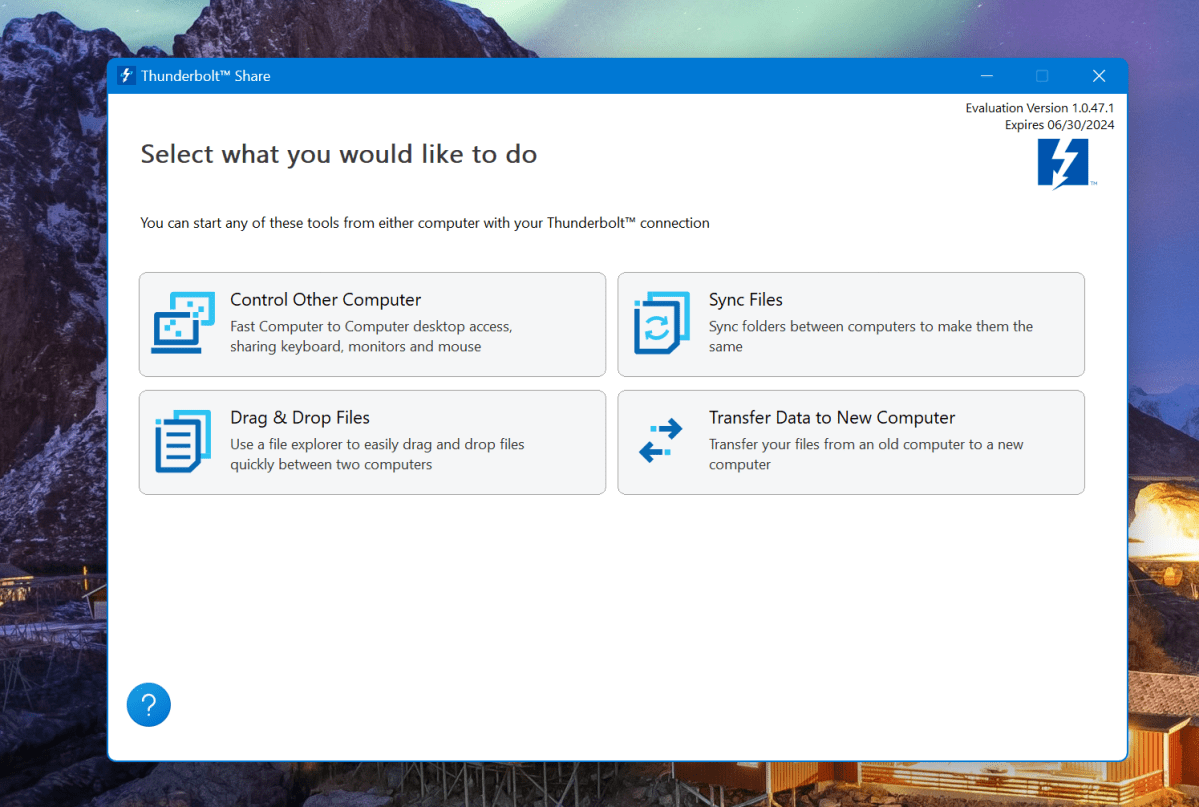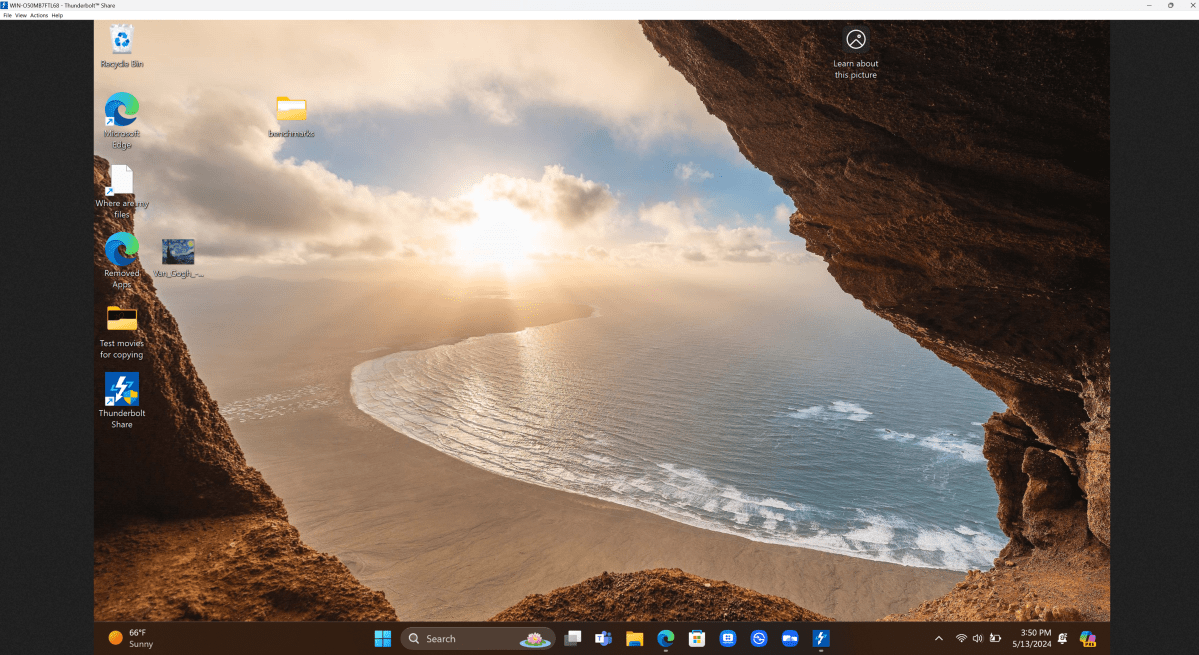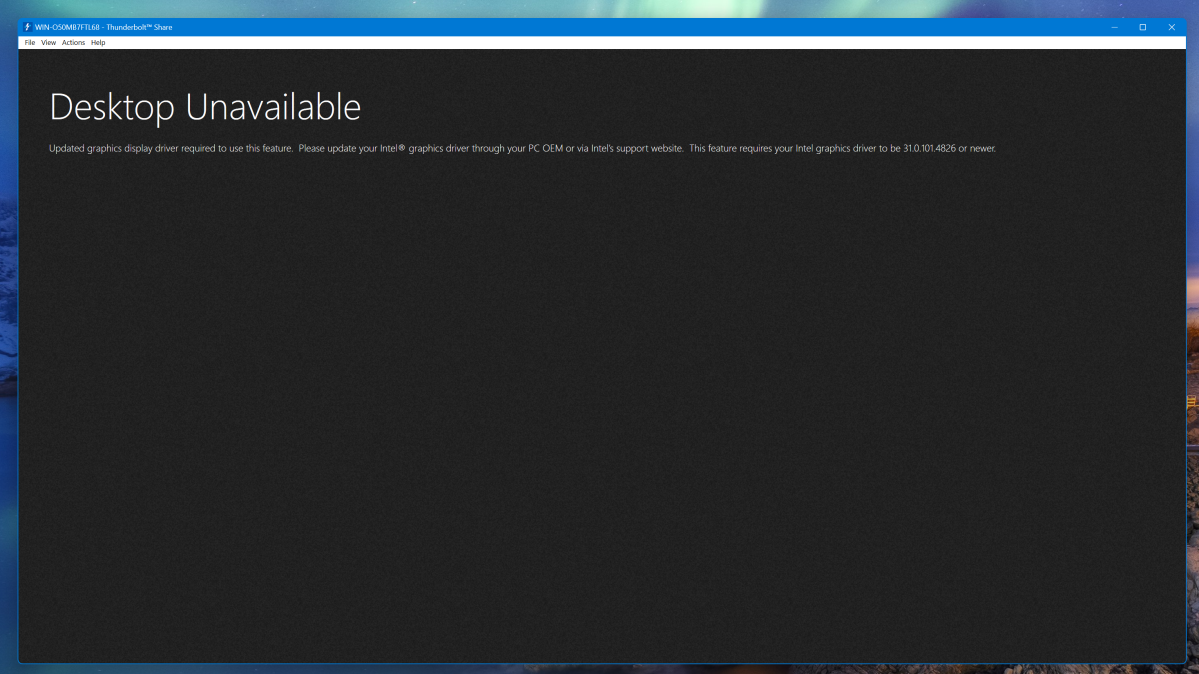With Thunderbolt Share, Intel is turning the Thunderbolt cable into a way to connect two PCs to one another, sharing files or controlling a PC. Simple, huh? Well, except that Intel isn’t exactly making it available to everybody.
Thunderbolt Share is a new Intel specification that connects two PCs via a cable, one to each Thunderbolt port. Alternatively, you can connect it to a Thunderbolt dock instead. Thunderbolt Share offers several options, all at blazing 40Gbps or higher speeds: control another PC, transfer files, sync them, or even migrate one PC to another. Is it a killer sneakernet replacement? Sure seems like it for local networks.
The idea? You or your family own more than one PC. If they’re Thunderbolt-capable, Share will unlock a number of handy additional sharing capabilities without needing to set up a workgroup, a network switch, or any other solution. Dock makers, too, will see an advantage: suddenly, Thunderbolt hubs like the Plugable 5-in-1 Thunderbolt Hub (USB4-HUB3A), part of our list of the best Thunderbolt docking stations, won’t just be designed primarily for external displays with Thunderbolt ports.
There’s just one thing. Intel didn’t take the simple route and just make Thunderbolt Share part of the Thunderbolt spec. Instead, Thunderbolt Share will be a software app Intel will license to PC and dock makers. And it won’t work for legacy Thunderbolt 3 or USB devices either — not officially, anyway. In short, you’ll have to keep track of which devices are Thunderbolt Share-capable, because without one, Thunderbolt Share won’t work. A special logo, however, will help.
Intel
“It’s really going to offer users an easy, fast, and efficient way to do more with your two PCs by securely sharing screens external monitors, keyboard, mouse, storage and all your files,” said Jason Ziller, vice president and general manager of Intel Client Connectivity Division, in a briefing with reporters.
A decade ago, Intel showed off something very similar: a 10Gbit Ethernet-over-Thunderbolt demonstration called Thunderbolt Networking. This is a faster version, an Intel representative said via email. Thunderbolt Share uses up to a 20Gbps connection over Thunderbolt 4 with low latency, and should achieve those speeds on recent PC models with some variability for different specifications.
How Thunderbolt Share works
Thunderbolt Share is designed to work only with docking stations and PCs that include either the Thunderbolt 4 or upcoming Thunderbolt 5 specification. You’ll also need the intermediary Thunderbolt Share software, designed by Intel, which will ship on licensed PCs. If you own a licensed Thunderbolt Share docking station, that accessory maker will point you to where you’ll be able to download the software. Remember, at least one of the PCs or docking stations must have a Thunderbolt Share license.
Once the software is installed on both computers, you’ll be able to connect the two PCs to one another using a Thunderbolt 4 or 5 cable, Intel says.

Intel
Once that occurs, you’ll have the choice of four different tasks:
Control other computer: You’ll see the other computer’s desktop in a window on your PC. You’ll be able to control it using your keyboard and mouse, and you can place that external PC’s window on your display. Essentially, you’re performing a local, cabled version of Microsoft’s Remote Desktop without all of the setup. Since all this takes place over a cable, you don’t have to worry about someone intercepting your communications on the Internet.

Mark Hachman / IDG
Drag and drop files: Nothing special, though the copy/move functions should take place at Thunderbolt speeds — between 80Gbps and 120Gbps speeds, depending on the specification.
Sync files: Presumably this works like syncing files to the cloud or so on: ensuring that files in two folders on the two PCs are in sync. It’s not clear which PC will be given priority, but it will most likely be the host.
Transfer data to a new computer: Remember PCmover? The PC-to-PC migration software (which Intel and Microsoft reportedly contributed to) used to even include a dedicated cable. This Thunderbolt Share function works like Windows Backup and Restore or one of our recommended backup programs, migrating your files (but not apps!) from one PC to the other at the press of a button. It’s not quite clear whether this includes things like system preferences, however.
Thunderbolt Share looks almost exactly the same as Bravura’s Easy Computer Sync, down to the text on the screen.
“Thunderbolt Share is built on both Intel and third-party technology (with appropriate licensing/permissions),” an Intel representative said in an email. “This ensures we can provide the best value to users and our OEM partners who are licensing Thunderbolt Share for their supported PCs and accessories going forward.”
Thunderbolt Share: who will get it, and who won’t
Intel didn’t explicitly say whether or not Thunderbolt Share will be a feature attached to its Evo Edition PCs, but it seems quite likely. While Ziller hinted that users may be able to buy a license to Thunderbolt Share in the future, that isn’t happening right away.
Given that Thunderbolt 3 and Thunderbolt 4 are almost identical, that’s not great news for owners of older Thunderbolt 3 docks. Owners of USB4 docking stations are technically out of luck as well — and given that AMD Ryzen laptops use USB4 ports in place of Thunderbolt, that means that owners of Ryzen notebooks are left out. Ziller said that Thunderbolt Share devices are identified “locally,” presumably meaning that they’ll have some sort of local authentication. But an Intel spokesman also confirmed that there’s no limitation in adding Thunderbolt Share to existing devices, provided that they meet Intel’s hardware requirements.

Mark Hachman / IDG
And, of course, not every laptop and docking station manufacturer will support Thunderbolt Share, either. Intel identified MSI, Lenovo, Acer, and Razer among the PC makers supporting the technology, and Kensington, Plugable, Belkin, and Promise as device makers which will support Thunderbolt Share. Again, you’ll have to have one device in a Thunderbolt Share connection chain that has a valid license. Plugable said that it plans to release a docking station that will allow one PC to drive other “headless” PCs without displays, using Thunderbolt.
However, one Thunderbolt Share licensee said that it’s still pursuing alternatives.
“While we believe that Thunderbolt Share will provide great benefits to creators, gamers, consumers and businesses, we are exploring additional solutions for seamless peripherals-sharing within Belkin docks,” a representative of Belkin, one of the Thunderbolt Share licensees, said in an emailed statement. “As we’re still in early days, we’re not ready to share our product plans but we’ll let you know as soon as we are.”
Thunderbolt Share hands-on
Intel provided an evaluation copy of the Thunderbolt Share software for PCWorld to test out. I performed my own tests, but my colleague Gordon Mah Ung tested the technology, too, in the video just above.
As Intel suggested, I downloaded and installed the Thunderbolt Share software on both of my test laptops, which each have Thunderbolt ports. I used a manufacturer-supplied Thunderbolt 4 cable; a generic 10Gbps USB-C cable just won’t work.

Intel
Once the software was installed on both laptops, simply connecting the cable opened the Share software, which offered me the four choices from controlling the other PC to syncing files. (Thunderbolt Share also works if you’ve plugged in your laptop in to an existing Thunderbolt dock with a second cable, by the way.)
Surprisingly, the most obnoxious roadblock had nothing to do with Thunderbolt or the software: I wanted to control one PC via the other, and the software wouldn’t do so until I had downloaded an up-to-date Intel integrated graphics driver. (Most PC makers recommend that you download drivers through them.)
Controlling one laptop with another doesn’t quite feel like you’d be able to sneak in a bit of gaming on a personal gaming laptop, controlled remotely. (Edit: Intel believes that you’ll see rthe other PC’s desktop at 1080p, 60 frames per second.) Streaming video, for example, was a little stuttery, though not too bad. Audio doesn’t transfer across the Thunderbolt Share bus, however. It is handy to be able to poke around another laptop for a missing file, however.

Intel
That might be, while the other Thunderbolt Share functions feel vaguely similar. My testing of the best Thunderbolt docks at PCWorld involves copying a folder of files from a connected SSD over a dock’s Thunderbolt cable; it took just about the same amount of time (1 minute 6 seconds) to copy the folder from one PC to the other. Weirdly, it took quite a while (three minutes!) to copy the folder from the remote SSD to the remote PC, not touching the local laptop; it took 1 minute 20 seconds to copy the file from the remote drive to the remote PC.
Syncing a folder worked fine; the default are the major folders (Documents, Videos, Photos, et cetera) but you can specify a particular folder if you so wish. The only feature I didn’t test was copying files as part of setting up a new PC.
So why isn’t Thunderbolt Share part of, say, the Thunderbolt 5 spec? According to Ziller, Thunderbolt Share is a “value-add” feature: you won’t get any benefit if you own a single PC. For that reason alone, Intel is separating it out, trying to benefit gamers and creators who work back and forth on different PCs.
Granted, a Thunderbolt cable is just another cable on your desk. A Thunderbolt dock already has wires snaking back and forth to your PC, to displays, to SSDs and so on. So there’s that. On the other hand, Thunderbolt Share honestly sounds like a decent solution to solve the “sneakernet” problem that just won’t go away.
Additional reporting by Gordon Mah Ung. Story updated at 10:49 AM to clarify the expected resolution of a shared PC.



